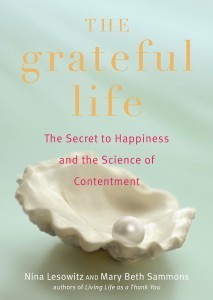Holly Lynn Payne's Blog
January 29, 2015
Confessions of a Cell Phone Addict: And a Cure
As published on Huffington Post
I’ve just emerged from 94 hours unplugged at a hilltop monastery off the coast of Big Sur, California. Last year, I did the same thing but for different reasons. My friends thought I was nuts. I told them I needed to unplug, sleep, write and think. I didn’t go for vespers, prayer, or any service. I’m not even Catholic; however, I had a confession: I am addicted to my cell phone.
I was snorting email and texts like a coke addict.
I felt my heart pound, and not in a good way, when I lost the last bar of reception a few miles north on Highway 1. How would I know my daughter’s conjunctivitis was going away? Would she be okay while I was gone for five days? What if a friend needed to talk? What if I did? I was on my way to a silent retreat. No Wi-Fi. No cell phone. Here we go, I thought. When I drove up the steep driveway to the reception, I felt less like a retreatant and more like a reluctant “guest” at the Betty Ford Clinic. I have never abused substances, but technology seemed game.
Who would ever know? I appeared in balance. I didn’t sleep with my phone, at least.
First, there is irony in all of this. For years, I prided myself on being a late adapter to technology. I was the last person of all my friends to get a cell phone and the last to convert to a smart phone. I am a skeptical consumer. I grew up in Amish Country. I boasted a love of minimalism and simplicity associated with aesthetics. Less is more guided my buying habits and helped keep my home, closet and office in check. But my head had become cluttered and chaotic. I had become an information hoarder. It felt gross and completely out of whack — and character.
A constant need to see incoming emails and texts drove me to check my phone at least every 10 minutes of my day. I even found myself checking emails before a hike, when the whole point of the hike was to unplug for an hour at least. What could I possibly do with that information? Did any of it matter? It’s not like I had a sick relative or friend in hospice. I mean seriously.
Here’s the kicker. It’s not even like I was compelled to respond. Responding wasn’t motivating me to keep getting a hit of “connection.” I knew everything could wait. Why couldn’t I?
It got worse. It’s one thing to keep a technology addiction hidden at work. No one has to know, unless you’ve adopted some very helpful apps to keep you off the Internet when you actually need to get work done. The dark side of my addiction seeped into off work hours.
How addicted was I? You be the judge. My own assessment might be mild compared to most. Or more severe. Wherever the pendulum swings, we all find ourselves on it, somewhere.
Here’s a snapshot. When I was waiting to pick up my daughter at preschool, I snuck in a peek. While my daughter swung from the monkey bars at the playground, I eventually got careless and pulled out my phone, in plain sight of other parents and kids and texted away, LMAO at inside jokes no one around me could understand. While I cooked dinner, I responded to more texts.
Silly things. Fun stuff, right? Harmless. In the midst of conversations, I still responded to these things, and when I had a chance, because why not, I returned emails. Done. Off the list. That felt good. But did it really? What benchmark was I measuring myself against if all my life had become were mostly online moments interspersed by, oh yes, real life?
I had become that parent and person I had detested. I was choosing the phone over my child during the most precious moments of her life. A few times at dinner, I even hid my cell phone on my thigh, under the table to see what rolled in — turns out nothing that needed my immediate attention other than the people in my immediate presence.
I was in bad shape. I just didn’t know how bad until I had 94 hours to unplug for real. Who sweet talks a monk into a password anyway? If this sounds blasphemous, it is. My imagination was painting lots of scenarios, that, should I find the disconnection unbearable, I could find my way out of. I could get in my car and drive five minutes down the road to a store that carried wireless. I could pay for access. But I refused to get in my car and so I let it sit for five days.
The monastery is not a place for everyone. I lived in a trailer with a single bed, desk and rocking chair. The one luxury, other than a hot shower, was a small kitchen with a propane burner; however, when I first attempted to light it, I almost singed my eyebrows. That would have saved me some expenses in waxing, but still. There were dented screens and drafts, ants and moths and mice. Maybe a bit too extreme for some. There were a lot of other places I could have gone with my five precious days. I didn’t want yoga classes, the noise (albeit well-intentioned) of gurus, workshop leaders and life coaches. I just needed everyone and everything to shut up, please.
I wanted raw. I wanted real. I wanted to re-awaken to the details of my life that mattered. After the first few hours of withdrawal, something happened. My mind quieted. I could hear my voice for the first time all year, really. I could hear the sound of the blood in my ears, it was that still and quiet, other than the occasional visitation from housekeeping to reset the mouse traps.
I managed to read 2.5 books: The Art of Hearing Heartbeats, Jan-Philipp’s Sendker’s gorgeous and brilliant novel, set of course, in a monastery, The Power of Less by Leo Babauta, which gave me a compass for managing future email and texts, and Precision Marketing, by Sandra Zoratti & Lee Gallagher, which I realized was super helpful, but too much information for a hoarding mind. I wrote instead. I walked slowly. I ate slowly. I got clear about 2014 and what I wanted to create in 2015. I worked on a few new chapters of a novel. I sat still and admired the view of the sea, watched every single sunset and sunrise, and happened to see the full moon.
94 hours without Internet or cell phone gave me access to myself for the first time in months. Even with the ants and moths and mice, I’ll return again next year, if not before. I realized that my addiction to being “connected” had actually disconnected me from myself and my daughter.
So what are we feeding with our technology addictions? The gaping hole we experienced in the moments we feel most alone — at a restaurant when a friend is in the bathroom, at home, in our relationships, on the playground. The list goes on and on. I left the monastery restored. I drove slower up the coast. I fully appreciated the views of the mighty blue Pacific, and because I wasn’t concerned about all new incoming messages, I saw the blow spouts of three migrating whales.
Technology can only enrich our lives to the degree that we can stay present with ourselves and each other. I have to remind myself that I can still love my phone, but it will never love me back. The only “access” I need is to myself and the people that matter most. Everything else can wait.
November 3, 2014
Guest interview with Nina Lesowitz: The Grateful Life
With Thanksgiving just around the corner, I wanted to introduce you to a dear friend, fellow Litquake volunteer and dedicated writer, Nina Lesowitz, whose new book The Grateful Life will give you a reason to pause, take a deep breath and reflect on everything you have in your life. It’s easy to dwell on what’s not going right, what could be better, or how you’d like to change yourself (and others!), but Nina’s book helps us re-frame our idea of happiness and reminds us it’s as easy as giving thanks. An attitude of gratitude is just about the most potent medicine any of us can take. Enjoy!
What are you working on?
NL: My new book, The Grateful Life, was officially published last month while I was busy producing and/or attending numerous events for Litquake, San Francisco’s Literary Festival. I am working on what every author has to do these days following her book’s publication – social media marketing, radio and TV interviews, and book signings. But I’m immensely grateful for the opportunity!
How does your work differ from others of its genre?
NL: Our books differ from others in the “gratitude genre” because they are not academic treatises or written entirely from the author’s personal perspective. They differ from other books in the inspiration genre because they are guidebooks as told through stories of people. We highlight the science behind gratitude’s many benefits and provide tips and practices to motivate readers into action.
Why do you write what you do?
NL: Writing a nonfiction, self help book is vastly different than creating a work of fiction. I am in awe of the talents of writers who have mastered character development, dialog, symbolism, and pace. Funny, my co-author Mary Beth Sammons and I advise others to counter their inner critic and focus on self-appreciation, yet here I am devaluing my contributions. I guess that’s why I partly why I write these books – I still need to work on myself!
I believe in the power of both literature and nonfiction to transform lives and teach us another way to be in the world. I hope that my books help others open themselves up to new possibilities. I am drawn to the ways that we can rewire our brains – at any age – to overcome anxiety, connect to a sense of purpose, and experience happiness in our daily lives.
How does my writing process work?
NL: My books have all been co-written, most recently with Mary Beth Sammons, who lives in Chicago. We send each other ideas, but we work independently on stories and sidebars. Our books take shape as we write these stories, and they flow organically into chapters and sections.
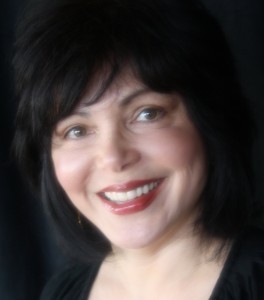 About Nina Lesowitz
About Nina Lesowitz
Nina, along with Mary Beth Sammons, co-authored the best-selling Living Life as a Thank You, and What Would You Do if You Knew You Could Not Fail?: How to Transform Fear into Courage. When she is not producing events for Litquake or writing books, she gives thanks for the waters around the San Francisco Bay, where she and her husband sail their boat Gratitude. She’s thankful for the sea lions and dolphins that swim alongside her in those waters, and for the wind and currents that carry her to new places to explore. She is the mother to two grown daughters and a very small dog and cat. When Nina is not sailing, writing or producing, she is hones her urban gardening skills in Alameda, CA. She has a degree in English from San Francisco State University. To meet Nina, click here: http://thegratefullifebook.com/
Facebook
https://www.facebook.com/TheGratefulLife
Twitter
@gratefulllife
September 24, 2014
Introducting debut novelist Kristen Harnisch
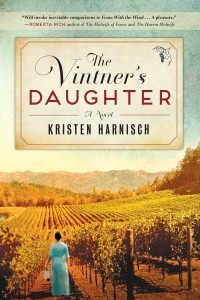 I had the pleasure of meeting Kristen Harnisch two years ago on a frigid New York morning at the Writers Digest Conference in Times Square. She struck me as one of those writers who dug into her work without complaint and endeavored to write the best book she could. I’m pleased to say she has gifted us with The Vintner’s Daughter, a marvelous journey into the life of a French born vintner who makes her way to California to avenge the death of a loved one in the late 19th century. I live just thirty minutes south of Napa and Sonoma counties and was delighted to learn about the fascinating history of the wine industry. Thank you, Kristen, for such a captivating read and for taking the time to chat.
I had the pleasure of meeting Kristen Harnisch two years ago on a frigid New York morning at the Writers Digest Conference in Times Square. She struck me as one of those writers who dug into her work without complaint and endeavored to write the best book she could. I’m pleased to say she has gifted us with The Vintner’s Daughter, a marvelous journey into the life of a French born vintner who makes her way to California to avenge the death of a loved one in the late 19th century. I live just thirty minutes south of Napa and Sonoma counties and was delighted to learn about the fascinating history of the wine industry. Thank you, Kristen, for such a captivating read and for taking the time to chat.
What are you working on?
Currently, I’m awaiting my editor’s review of The California Wife–the sequel to The Vintner’s Daughter—scheduled for publication in late 2015. From October 10-12, I’ll be visiting the San Francisco Bay Area to take part in Litquake, the area’s annual literary festival, and to continue The Vintner’s Daughter book tour in Napa and Marin counties. I’m also beginning my research for the third book of the series, and I plan to start writing the manuscript this November. I’m busy, but having fun!
How does your work differ from others of its genre?
My historical fiction debut differs from other works because, although the novel is character-driven with romantic elements, it explores the business of French and Californian winemaking in the late nineteenth century. In each scene, I want the reader to see, hear, feel, smell and taste the world as these vintners did in 1896. Over the last 150 years, the whims of Mother Nature, the politics of the temperance movement, and the economic perils of wine price wars have all brought winemakers to their knees. How did they persevere and prevail over these obstacles and their own human frailties? I strive to answer this question in this series of novels.
Why do you write what you do?
Writing historical fiction allows me to explore and to share my discoveries with readers. It also gives me free license to create an imaginary world in which readers can immerse themselves and hopefully learn a few things. The inspiration for The Vintner’s Daughter came to me in a flash. In 2000, I was standing on the edge of a Vouvray vineyard in the Loire Valley, marveling at the whitewashed winery, the rows of pristine chenin blanc grapevines, and the centuries-old limestone cellars. I knew a vineyard would be the perfect setting for the novel that I’d always hoped to write. Yet, I had so many questions. Who were these families who’d made wine for generations? How did they choose the grapes they grew? What challenges did they face? When I returned to the States, I researched the history of winemaking—and it fascinated me. I wrote The Vintner’s Daughter to share my fascination with the world.
How does your writing process work?
As the mother of three young children, “sporadic” is the best word to describe my writing process! Generally, I craft a two-page novel summary, a descriptive list of scenes, and I complete a fair amount of research before I begin. However, once I begin, I don’t write the scenes in any particular order. I usually write in three-hour blocks and I tackle the scenes that I’m excited to create on that day. This strategy keeps me invested in the process, and helps stave off writer’s block. At the end of each chapter, I also ask four questions of my reader-self:
1) Does this scene move the plot forward?
2) Do the descriptions create vivid pictures in my mind?
3) Is the dialogue crisp and fast-paced?
4) Am I dying to turn the page and read on?
Until I can honestly answer “yes” to these questions, I revise, revise, revise!
 About Kristen: Kristen Harnisch drew upon her extensive research and experiences living in the San Francisco Bay Area and visiting the Loire Valley to create the story for The Vintner’s Daughter. When she’s not writing, Kristen is chef, chauffeur, laundress, nurse, shrink, shopper and maidservant to three young children and one terrific husband. She loves vanilla skim lattes, dark chocolate, all wine, and inspirational stories. She has a degree in economics from Villanova University and currently resides in Connecticut. To meet Kristen, click here for a listing of her upcoming events in the San Francisco Bay Area. Find her on Facebook and Twitter @KristenHarnisch.
About Kristen: Kristen Harnisch drew upon her extensive research and experiences living in the San Francisco Bay Area and visiting the Loire Valley to create the story for The Vintner’s Daughter. When she’s not writing, Kristen is chef, chauffeur, laundress, nurse, shrink, shopper and maidservant to three young children and one terrific husband. She loves vanilla skim lattes, dark chocolate, all wine, and inspirational stories. She has a degree in economics from Villanova University and currently resides in Connecticut. To meet Kristen, click here for a listing of her upcoming events in the San Francisco Bay Area. Find her on Facebook and Twitter @KristenHarnisch.
August 27, 2014
Divine Laughter: Robin Williams’ Reverence
As published on The Huffington Post Aug. 25, 2014
It’s been a sad, gray time here in Marin County — and the world, as the news of Robin Williams’ death sinks in. Everyone seems surprised by it. How could the man who made us laugh so hard end his own life?
Doesn’t make sense, we keep saying, but in the most twisted way, it does.
Depression is the most determined of demons, and somehow, I bet Robin Williams would have found a way to make that funny. Not ha-ha funny, but he’d let us see the cruel conundrum that many of us secretly experience or witness firsthand — and as a result, help us release our quiet shame, guilt and anguish through a burst of laughter.
No one’s laughing about Robin’s suicide, that’s for sure. We’re shocked, struck by the loss not just of his life, but also at the loss of so many lives to severe depression.
Those who have condemned his suicide as a cowardly act don’t quite understand the complexity of the illness that depression is. I’ve lost two classmates to suicide, one a talented novelist. Exactly one year ago, a dear friend’s daughter, at the age of 17, jumped off the Golden Gate Bridge. She had just started high school. She was loved by many for her sweet disposition and bright spirit. She wanted to be a doctor.
Turns out, a lot of people suffer from severe depression, more than most of us are willing to admit. A former childhood neighbor of Robin Williams, the beloved writer Anne Lammot, shared a bit about her own battle with depression in a recent blog.
“Here is what is true: A third of the people you adore and admire in the world and in your families have severe mental illness and/or addiction. I sure do. I have both. And you still love me. You help hold me up. I try to help hold you up. Half of the people I love most have both; and so do most of the artists who have changed and redeemed me, given me life. Most of us are still here, healing slowly and imperfectly. Some days are way too long. And I hate that, I want to say.”
How many other exceptionally creative people like Anne Lammot wage a war dance with depression from time to time? It takes a very porous disposition to absorb the world and reflect it with honesty, the way writers, actors, artists, musicians and anyone else who helps us understand the human condition and make sense of life.
It also makes sense then, when depression takes over the artist’s mind. Seems like a very natural part of the job worth mentioning. Unfortunately, we rarely do.
The fulcrum from which the most successful comedians draw their best material is often from the pain they have endured or witnessed in the world. Comedians are the purveyors of shadow and light, and they make it safe to recognize the darker, more embarrassing and downright humiliating aspects of ourselves. Robin Williams’ greatest talent was that he made it safe for the rest of us to be real — and flawed.
That’s why we love great comedians. No one wants to fight a person who can get them to laugh. Laughter is not entertainment at first. It’s a survival skill — for love.
I once took a weekend comedy writing workshop at UCLA. I was excited. I’m not funny at all but I wanted to learn how to tell a joke and infuse my writing with a bit more humor. Drama, they say, is the easiest to write. The greatest learning? Comedy is not about jokes at all. It’s about lying, scheming, reversals, surprises. I had no idea.
If the comedian is focused on shadows and has the courage to look at aspects of ourselves that most people are too afraid or embarrassed to do, doesn’t it make sense that in the worst situations, suicide appears to be a release from the pain?
Is it also possible the circuitry somehow gets overblown in artists as brilliant and electric as Robin Williams? Anyone who had the privilege of hearing him perform live, knows the energy in the room. It’s as close to sticking your finger in a socket.
Occasionally, Robin did surprise appearances at the Throckmorton, a local theater here in Mill Valley, where comedian Mark Pitta puts on a show every Tuesday night. After six comedians, Mark walked out and introduced Robin Williams one Tuesday in December 2009. I was floored to see him live and burst into applause with the rest of the audience. Robin’s holiday gift to the locals — way better than seeing Santa.
That night, he gifted us 90 minutes of laughter while he practiced some material about the disastrous Cosco Busan, a 901-foot-long cargo ship, that hit the Bay Bridge and spilled 53,000 gallons of heavy bunker fuel into the bay a few weeks prior. Not that destroying 69 miles of shoreline or killing thousands of birds was funny. Robin went another direction. He poked fun of the captain of the ship. We died laughing.
Then he went on to other things, like an acrobat on stage, his mind blazing, his blue eyes gleaming with that gentle smile that put everyone who knew him at ease. He was a generous man with a big heart. He was a neighbor, a normal guy we saw at the store, a fellow cyclist and parent. He was happy. Sad. Excited. Depressed. Just like all of us. Yet unlike anyone else, he was a masterful magician of shadows — playing with his own and ours like puppets and making us laugh at our foibles and flaws.
We died laughing in his presence. He helped old energies — the dark junk, to die in us every time he made us laugh. He cleared us out for some new delight. More than a comedian and talented actor, Robin Williams was almost mystical in his understanding of the energy of laughter. He understood its divinity — its power to connect, to release, to renew. The tragedy here is ironic in a way that Robin Williams probably (and privately) acknowledged, even without any other perceived options to end his own pain. He was our healer who could not find a way to heal himself.
Need help? In the U.S., call 1-800-273-8255 for the National Suicide Prevention Lifeline.
August 11, 2014
Spiritual Divorce: Taking a Page from Rumi and Shams
Published on Huffington Post, Aug. 5, 2014
The debate about “conscious uncoupling” — divorce without guilt, shame or finger-pointing intrigues me. Surprisingly, it’s not a modern trend, but an approach that even the great Sufi poet Mevlana Rumi had adopted to deal with the separation from his beloved muse, Shams of Tabriz.
My folks have been married for 51 years, and there’s not a single divorce on either side of their lineage. So when I recently broke that perfect family record, you better believe I felt guilty, ashamed and utterly depressed. It was like I took a chainsaw to the family tree and lopped off the top of the ancient sequoia. I never thought I would be a divorced mother, and I felt like a complete failure, even though I had indeed “consciously uncoupled.” What would Rumi say?
I married well into adulthood at 36, putting me nine years past the national average of 27 for women (and 29 for men) in the United States, according to the 2013 Knot Yet report. My partner was almost 49. From the outset, we were aware that no marriage was a fairytale. We weren’t kids. We’d both held out for “the one” and believed we’d found it in each other. I’d gone to countless retreats and workshops, and devoured books on the subject of marriage and relationships. I knew from my own childhood that marriage had its ups and downs, but that you stuck it out; you evolved.
Though my partner had come from a family complicated by divorce many times over, he too understood what marriage involved. Like me, he wanted a partnership that would last until the end of our lives. We were what Rumi and Shams might call “a very conscious couple.”
In the spring of 2008, we said our heart-crafted vows to each other in front of 150 of our closest friends and family. It was one of the most powerful and beautiful moments of my life. I’m a writer; and I value keeping my word with others. That day we promised to honor the truth in the other and support it, including the foreseeable changes of following our path.
We both knew that marriage required work and commitment as much as compassion, kindness and humility; however, we weren’t exactly abiding by that. A close friend who was aware of our troubles told me, “Love is like a river, but sometimes it goes underground for a while and resurfaces.” If felt like our love had been sucked into a tornado. The dynamic between us wasn’t working — in fact, it was killing our spirits. My friend assured me, like so many of my married and remarried friends, that all marriages had issues. I heard a lot of secrets. I knew we weren’t alone.
We’d address our problems like any sane and sober couple. Neither one of us wanted a divorce. Who does?
When our marriage started to unravel further, we tried everything we could to salvage it, including years of therapy, couples workshops and a six-month separation to unplug from a toxic dynamic and start fresh. I was so hopeful that we’d reunite that I made reservations for our fifth anniversary at a quaint farm house inn in Olema where we spent our first Christmas. I imagined us triumphant, looking back at our separation as the smartest action we’d ever taken to save “us.”
But four weeks into our separation, my partner confirmed that salvaging the marriage was not an option. I had to face the harsh reality that we were actually headed for a divorce. In heated arguments, I had thrown down the D-word more than once, and now it had come back to haunt me. I was deeply ashamed that it had come to this painful truth: Our daughter, who was just shy of her third birthday, would grow up in two separate homes.
I fell apart. I was brought to my knees, and even thought about ending my life in some dark moments. The mind does a wild dance when its terrified. I had lost my marriage, and any hope that my young daughter would have the idyllic childhood that we both had envisioned for her.
Was all of this some dark cosmic joke? In 1273, Shams told Rumi, “I am not in the position to order you to go on a journey, so it is I who will be obliged to go away for the sake of your development, for separation makes a person wise.” I wanted to believe that was true, that there was some redemption in all of this. Would the darkness offer some kind of forced growth?
My daughter was well aware of my strife. A child of few but insightful words, she asked, “Mama, why are you crying?” And later, out of the blue, “It’s hard having two homes and one life.”
Recently, driving back from a friend’s house, she said, “Can papa move back into the garden house so that you can make us pancakes for breakfast?” I burst into tears and pulled over because I couldn’t see to drive on a six lane freeway. The pain comes and goes but always hits like a tsunami — and yet, day by day, I know that this is my truth as much as her father’s.
Did our divorce blow up the perfect picture of my life? Absolutely. Have I been able to navigate this consciously with my ex-husband? Surprisingly, yes. Here’s how we “consciously uncoupled.” Our number one priority was our daughter, not money or material or custody. We could give a rat’s tail who got the Le Crusset Dutch oven. We already agreed about dividing things equally. We went Dutch on the first date — some things just predict the future.
Our focus was our daughter. We never wanted her to have to choose between us. We wanted her to know that she was the best outcome of our marriage, and that we cherished our bond (and still do) because it permitted us to bring her into the world. Our daughter sees each of us almost every other day. We’re making it work. There’s no formula for love.
We spend birthdays and holidays together. We speak highly of each other in her presence and yet we all know there is no turning back. We are not going to remarry each other. We want her to know that we will always love each other, and despite our fractured frame, we are still a family — and a loving one capable of joy.
Should my ex-husband and I, and the many other parents who choose to consciously end their marriages, feel like they’ve failed? It’s too early to know. We have young children. I wager this is a much different and more difficult situation with older kids. The question is can we still raise mature, loving, responsible adults despite divorce? Will our children feel deeply loved? In the end, isn’t this the test that matters most and from which we’ll know we succeeded?
August 1, 2014
Laugh loudly, ladies! Let them hear your joy in Turkey

Author Holly Lynn Payne smiling and laughing loudly this summer with her Turkish sisters around the world.
After hearing the uproar this week about Turkey’s Deputy Prime Minister condemning women from laughing loudly in public, my response was shared by thousands of women across the world. I laughed out loud and then I cringed. I could hardly believe the report from the BBC on National Public Radio.
Just one hour before, I was working with a female colleague from Istanbul on a Skype call. “Did you hear about what’s happening today?” She was on deadlines for her clients in the States and had not yet been informed. “Just make sure you go out and laugh in the streets.” When I told her why and she, too, burst into laughter. “That’s absurd,” she said.
Yes. Completely. Twitter went nuts with responses and soon thousands of Turkish women, and other women showing solidarity, posted selfies of themselves laughing. According to Reuters news agency, Deputy Prime Minister Bulent Arinc, urged women not to laugh in public to “protect moral values.”
So what moral values is Mr. Arinc protecting by condemning women for laughing (loudly or otherwise) in public? Even the Turks most beloved Rumi would cringe, especially during this month of Ramadan. Apparently, Arinc meant to address both men and women and encourage them to adopt ‘ethical behaviors.’
It only got worse when Arinc, a co-founder of the very conservative AK party, responded to the outrage. “The woman should have chastity. … She should not laugh in front of everyone and not be inviting in her behavior. She should protect her honor,” he said, inadvertently infusing the context with more absurdity.
My confusion only deepens here. What does Arinc mean by ethical behaviors or inviting in behavior? I would love to hear ESPN’s Michelle Beadle’s response to this, especially the notion of ‘inviting in behavior.’ Is Arinc still one of those men who actually think a woman’s power is evil? That her choice to wear a short skirt in public, or express herself in whatever way she wants, is a reason to silence her?
One comment from a man like Arinc makes me feel like we’ve slipped back a few millennia, and have forgotten that no one has the right to threaten anyone’s birth rights. I’m always curious if the God that the Turkish deputy prime minister celebrates during Ramadan has an account on Facebook and Twitter. At the end of a women’s life, will this ‘God’ show her how many time she’s laughed in public, let alone flashed her pearly whites? I’m hoping when my daughter is old enough to understand what happened July 30, 2014, she will take a selfie in solidarity and remind herself that laughter is not only her right, but one of her powers.
It’s a bit sad and banal. Men like Arinc are clearly still living in an age of fear, terrified of women who express themselves freely and completely. I may not be a Muslim or celebrate Ramadan, but from what I know and have studied, it is a time of reflection, of cleansing one’s heart of impurities—malice, for one (take note Mr. Arinc) and all the ways that we deny ourselves and others love. It’s about finding ways to be charitable to those less fortunate, and on the 29th and last day, a way to express gratitude for all the ways God has provided for us, including the infinite ways of self-expression we are given at birth.
I’m not worried about the women in Turkey. I am grateful to see your strength and your gorgeous smiles. Keep Tweeting the selfies. The vibration within those self-portraits speaks volumes for how you refuse to be subjugated or diminished because of your God-given rights. Show them your teeth, my sisters, and keep laughing. Laugh so hard that it will bring tears of joy to your adversaries—the sad, small and fearful men, who still don’t get it.
When women show their smiles and laugh, the world lights up—and maybe that’s all Mr. Arinc needs?
I leave the Turkish Deputy Prime Minister with a thought to ponder while he sips his coffee and stews over the outpouring of criticism. After all, your most beloved poet, Rumi, would be turning over in his grave in Konya. Rumi was well aware of the power of laughter: “That which God said to the rose, and caused it to laugh in full blown beauty, He said to my heart, and made it a hundred times more beautiful.” It’s not too late, Mr. Arinc. You still have a chance to laugh, too, and bring the world more joy. I dare you to try.
May 20, 2014
How I Met Rumi
First, a confession. Though I’m about to publish a new book, DAMASCENA: the tale of roses and Rumi, I had no idea who Rumi was when I sat at his tomb in 1998. I had never heard of Rumi. I was doing research for my first novel about a famous Turkish rug weaver, The Virgin’s Knot, which sent me on a wild journey through Turkey to learn about rug weaving, Turkish folklore and culture. So why wasn’t Rumi on the radar?
I was raised in a Lutheran church in Amish Country, south central Pennsylvania, a mostly German culture. We ate giant soft pretzels, not pita bread (at least until the late 80s). In school, we studied English poets, not the work of a man who lived nearly 800 years ago in medieval Persia. What I heard about was Turkey.
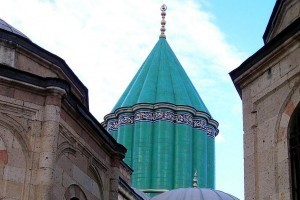
Mevlana Monastery of the Sufi Dervish order, Konya, Turkey
I wanted to go ever since my oldest best friend fell in love with Istanbul. I craved a direct experience in the fabled city of flying carpets, fig trees and sultans. Mostly, I wanted an adventure that didn’t put me in the hospital like the one where I was struck by a drunken driver shortly after college. I needed something fun that could also push my edges. In the spirit of Thoreau, I wanted to ‘stand up to live’ before I sat down to write. Traveling to exotic lands seemed like a good choice. Something about traveling alone, in my mid-20s, as a young woman in the Middle East, seemed as close as I could get to working as a foreign correspondent. Even if I was gathering research for a historical novel, the journalist in me refused to quit.
I was sobered by my experience in Konya. I lived with Mehmet Ucar and his family for a week. Mehmet is the self-made, beloved rug merchant of Konya, who grew up in a village in the Taurus mountains. He built himself quite a reputation with his shop, Ipek Yolu (Silk Road), and the rugs he acquired and sold over the years. He opened his home and his heart to me, and I loved that his wife wore no headscarf and worked as a nurse in the local hospital. His two young daughters had short hair and played soccer, while they lived next door to aunts and uncles who looked straight out of a description from Freya Stark’s books. Billowing cotton pantaloons, long skirts, tunics and vests. Bright headscarves framing joyful faces. Mehmet seemed to be the bridge between generations of women, supporting the tradition of rug weaving while rallying his wife and daughters to demystify traditional roles assigned to Muslim women—especially in Konya, Turkey’s most conservative city.
Mehmet sat me down one afternoon in a small, square, dusty shop made of turquoise aluminum where he stored colorful skeins of wool. We spoke of life. My accident. Recovering. Finding ‘my man.’ He said, “You are like daughter to me. Love is not between the legs. Love is always here,” he said and touched his hand to his heart. The next day, his cousin, Muamar (who would become a character in The Virgin’s Knot along with Mehmet without any name change), took me to the largest building in Konya. We had passed it several times already. I knew it was a mosque. I saw all the shoes lined up outside the building and men entering, carrying rolled up prayer rugs on their shoulders. I didn’t think I’d have a chance to enter, because I was a woman.
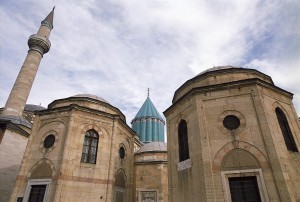
Teke (monastery) and Rumi’s tomb, Konya, Turkey
Mumamar, two years my senior, showed me the way. I covered my head with a headscarf and got on my knees on one of hundreds of prayer rugs covering the huge floor. The ceiling was framed inside a massive dome and I swear it felt like the universe could fit inside it. Maybe it did. The next thing I know, Mumamar led me into another building close by and another room, filled with several sarcophagi. “Rumi,” he said, “Is buried here.” His eyes were wide and he stood in deference to the spirits there. I stood speechless and awkward. I didn’t know who Rumi was. I had no clue where I was or what had transpired there.
At the time, I had no context for the man Rumi, his life, his work, or his impact on the world. But I can tell you standing in that room (and writing about it now), gave me chills unlike any I’d experienced in my life. Not spooky chills. Chills that explode through your heart. A current charged the air and a doorway opened for me. It would take nearly a decade for my mind to catch up to the ‘current’ that day and to recognize it as Rumi’s signature energy. As soon as I returned to San Francisco, I got a copy of Coleman Bark’s The Essential Rumi. Studying it and the rare English texts written about Rumi’s life inspired DAMASCENA: the tale of roses and Rumi. Rumi’s presence showed up during the writing in strange, undeniable and inexplicable ways that I will share in the next post.
February 13, 2014
Love is never lost.
It’s been a while since I last wrote to you, or shared any news. 2013 marked a turning point in my life—a shedding of everything I thought to be true. In the midst of a divorce, I hit rock bottom. And yet, despite the darkness and despair, I found a way to stay healthy and strong for my young daughter.
I hiked. I prayed. I got back on my bicycle and made friends with the road and the dirt, and the space afforded me, ironically, as a result of co-parenting.
This wasn’t my beautiful life, I told myself, ashamed and terrified. But it was—and the longer I held that picture of perfection, the more I suffered until it shattered.
One day on a hike, it struck me that I had the answer to climbing out of the darkness. While writing DAMASCENA, I had just spent the last decade studying the life and work of the great Persian poet and mystic, Rumi, whose definition of a Sufi was “one who is able to experience joy in the midst of great disappointment.”
Had I been preparing myself for this tragedy? Or had writing the book been merely a coincidence? Was it truly possible to find joy in the midst of all this pain? Yes. Yes! Not only was it possible, finding joy was the only choice I had—unless I believed depression would serve me and my daughter better.
I stopped on the trail and laughed for the first time in months. I understood what Rumi was saying. Find joy. That’s it. Find joy! I looked around and noticed purple iris rings blooming early in mid-February. I felt a small joy. It was momentary, but it was real.
Each day, I looked for some small joy to know that I was stronger than the pain. And each night, I prayed for more joy.
Over the months, Rumi’s wisdom delivered me back to my heart. I realized the divorce didn’t break my heart after all. It broke it open. Wherever you find your heart today, I hope you can trust the love never leaves. Just claim the love as yours—and share it.
If you live in the Bay Area, I hope to see you June 5 from 7 – 11 p.m., Fort Mason, San Francisco, for a book launch and Rumi rave to benefit Litquake. Wine, words, ecstatic dance! We hope it will be a truly transformational night for everyone. The Sufi Mariam Baker will be performing the sacred dance, sema, and after the reading, I invite you all to get down on the dance floor and share the love for this wonderful, wild and often crazy life.
“Dance, when you’re broken open.
Dance, if you’ve torn the bandage off.
Dance in the middle of the fighting.
Dance in your blood.
Dance, when you’re perfectly free.”
-from The Turn by Rumi
Lastly, as a Valentine’s Day gift, I wanted to share the first few chapters of DAMASCENA with you. I hope you enjoy the journey.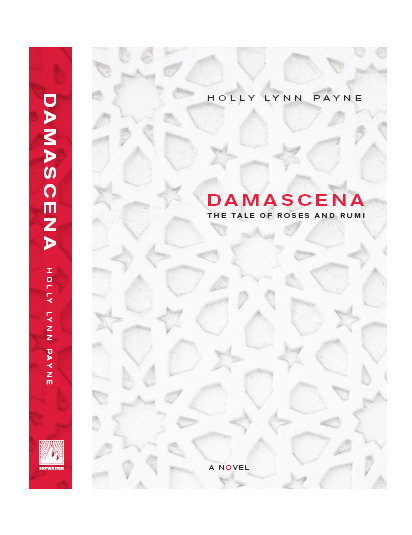
September 2, 2013
Fountain of Youth? Hike a ‘Thirteener’
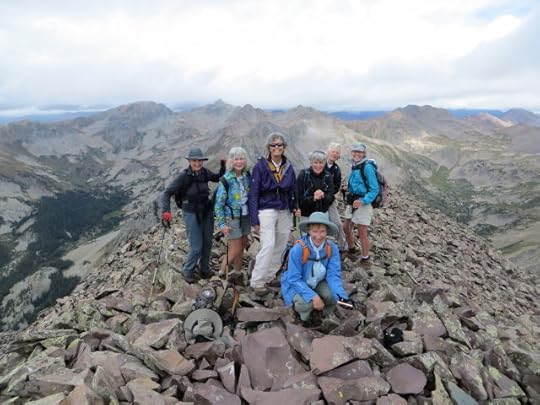
All in a day: the Butte Beauties of Crested Butte, Colorado summit Teocalli Mountain.
Each summer, I leave the comfort zone of sea level and ascend to roughly 9,000 feet for a few days. Sometimes to write. Sometimes to teach. But always to walk and ride on dirt. Crested Butte, Colorado is my favorite Rocky Mountain town just north of Gunnison, Colorado and thirteen miles south of Aspen‚ “as the crow flies.” In reality, it would take three hours to drive around the mountains to get to Aspen from here, or seven hours to hike across West Maroon Pass. To locals, this kind of endeavor is a familiar ritual, culminating in The Grand Traverse race for those hearty souls crazy enough to ski the same route. I have yet to do any of these feats, but marvel at the vigor of women at least twice my age who hike that stretch like it’s a Zumba class.
Meet the Butte Beauties, Phila Weatherly’s brainchild group that formed in 1986. Today, the group boasts more than 100 women, all over the age of 50, who ski together in the winter and bike, hike and camp in the summer. My best friend’s mother, Maureen Hall, has been a member for the last 17 years, and at the age of 67, completes seven hour hikes in a day, then returns to make dinner for her husband and houseguest (me) before she finishes a gazillion volunteer duties on the computer and confirms more guests at her son’s upcoming wedding. In other words, a hike this long is a normal day in the life of the average Butte Beauty.
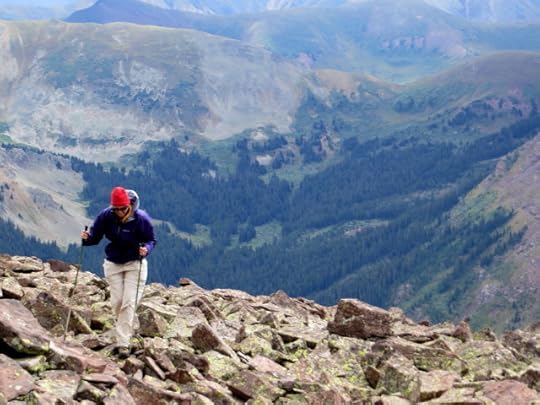
No excuses to stop moving. A 75-year-old Butte Beauty navigates a boulder field toward the summit of Teocalli Mountain, after a knee replacement and shoulder surgery.
“The only rules are that we have no rules,” Maureen write in an email. “No by-laws, etc. Everyone in the group has had a past life that involved lots of work, raising kids, doing charity work, etc. and now it’s just time to play.”
I’m particularly awed upon arrival when Maureen returns from her latest hike with a small group of Butte Beauties: summiting Teocalli Mountain in the Elk Mountain Range, which at 13,208 feet elevation, is by no means a casual stroll down a dirt path. Four of the eight women were over 70, and one with a replaced knee and reconstructed shoulder.
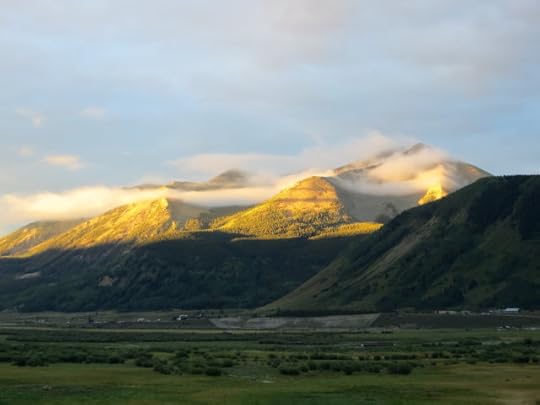
Another kind of heaven: morning fog drapes Whetstone Mountain in Crested Butte, Colorado.
Seriously. This is the kind of phenomena I anticipate when I visit Crested Butte. In fact, it’s one of the reasons I keep returning. A dear friend, battling a rare form of lymphoma, not only managed to ride with me on the 401 trail, one of the most beautiful and epic single track mountain biking trails in the country, but was kind enough to wait for me on the uphill and the descent. I always beg my Crested Butte friends to wear 20 lbs ankle weights when we head outdoors. It’s my only insurance that we’ll all finish together.

The Butte Beauties leave the Rockies to hike Mont Blanc, France. Go, ladies go!
The women who comprise the Butte Beauties humble and inspire me. They broke the rules about 15 years ago and invited me to join them on a ‘normal’ hike—to a series of lakes just above Scofield Pass. We set out on a lovely day, eating lunch overlooking the lakes when storm clouds blew in out of nowhere. We packed up as fast as we could, leaving the crusts of our sandwiches for the picas and high-tailed it across a scree field when lightning split the sky. Being that I have a foot-long titanium plate and ten metal screws in my femur, I concluded that I was a lightning rod and ran for my life to the car—what I did not account for in courage, I made up for in youth and speed, hoping that if something happened to anyone, I’d at least be able to do something to help. Turns out, the Butte Beauties didn’t bat an eye. Of course, they were concerned, but they literally took it all in stride, even though they don’t make a habit of venturing out in foul weather.
I hike a lot at home. A few times per week. Hour loops, nothing technical, except on longer weekend adventures. I thought carrying my three-year-old daughter on my shoulders to the West Point Inn on the top of Mt. Tamalpais, a mere 2,300 foot mountain near my house in Marin County, was a healthy effort but it’s not even close to what the these women do—for daily fun and vacation. Two years ago, Maureen and six other Beauties, all over 65, hiked the Tour of Mont Blanc in France. Treading dirt at high altitude, navigating boulder and scree fields is second nature to these women and make me realize there’s a whole series of adventures waiting for me and my own friends when our hair is silver and white, as long as we stay vital. May we all remember that ‘age’ is truly a state of mind and live by Placido Domingo’s wisdom, “When I rest, I rust.”
December 31, 2012
Last Breath—A Can of Swiss Air
While we say goodbye to 2012, I wanted to share a story about choosing joy in the midst of sadness and suffering. I didn’t think it could be done until I watched my friend and next door neighbor, Trudi, die last November. Trudi was Swiss and determined. Instead of a funeral, she chose a party for her closest friends and family.
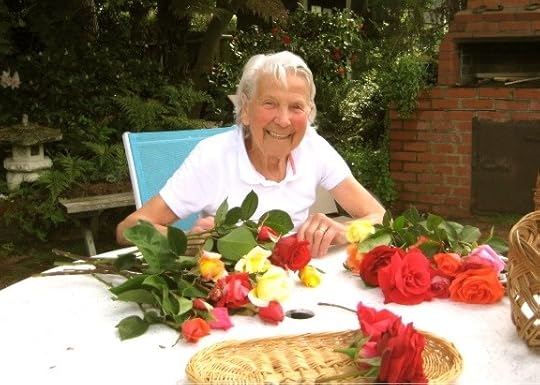
Everyone who knew Trudi knows generosity of spirit was one of her greatest traits, and her choice to squeeze joy out of her final days is a constant reminder of how I’d like to be in this new year full of uncertainty for so many of us.
Uncertainty? Trudi would probably give me a quick shrug and smile if I asked her. What’s so uncertain about the present? I need to remember this and that presence is a great gift.
During a bedside visit in her final three weeks, Trudi told me about her last trip to the hospital. She tore off her heart monitor and IV, lay them neatly on the sheets and requested to call her daughter. At 88, she was through with the sirens and surgeries, the poking and prodding, the panicked and too frequent rescues from the paramedics. October 28 would be Trudi’s last ambulance ride. She had led an active and independent life. She wanted to come home to die with her family and friends surrounding her.
The doctors gave her three days. She gave herself three weeks. Trudi was ready to depart but not that ready. She had a plan— a beautiful, methodical, mystical plan to wake us up to joy with her death.
First Impressions
The morning after my husband and I moved into our house five years ago—newly engaged, we opened the front porch to find a huge basket filled with tomatoes, cucumbers, shiny green peppers, and a hand-written note from Trudi welcoming us. I was struck not just by Trudi’s sincerity and how beautiful the vegetables looked in the light of that September morning, but by the kindness of our new neighbor: the tiny Swiss woman with the sparkle in her blue eyes.
When I reached down to pick up the basket, I remember seeing yet another surprise: a small bundle of roses, freshly picked and de-thorned, wrapped in a wet paper towel and tinfoil. The kind of roses that smack you sideways with their sweet scent and pure beauty.
I love roses but what I loved even more about Trudi’s roses particularly was that their arrival on our doorstep had just turned our first house as a couple into a “home.” In no time, Trudi had already touched us with her kindness and generosity of spirit.
When I learned how much Trudi loved to read, I immediately set about reciprocating her welcome basket by delivering books to her as often as I could. I didn’t know how fast she read, but soon found the books returned to me in brand-new Zip-Loc baggies with more hand-written notes: little Post-Its with Trudi’s brief but poignant book reviews.
“Oh, I loved it. I didn’t want it to end,” she would write, then often read the books again.
She devoured books so much that we have not had to buy many ZipLoc bags in the last five years. I honestly don’t know anyone, other than her granddaughter, who read as much as Trudi.
A Friendship Through Books
We started to spend time talking about books, what she liked—a good escape, she said, something with mystery but not so intense that it kept her up all night reading, even though it did. From our bathroom, I often saw the light in her room at night and smiled, thinking how happy the author would be knowing his or her words were being savored in those late hours.
Sometimes she didn’t savor every word. Once, I found her at the door with Hilary Clinton’s tome. It looked like it weighed a million pounds, and there Trudi was holding it with one hand, pumped by something I rarely saw in her: anger. She caught my eye when I swept over the title and she pronounced in her Swiss accent, “He was a little shit.”
I’d never heard Trudi swear before and stood there pleasantly stunned. I loved that Trudi could get so into a book, no matter what she was reading, that she literally embodied the storyline. It was the first time I’d seen a bit of her feistiness and it made me love her even more. As her husband Clorimondo always said, “She’s the boss.” To which she always smiled.
Whenever we visited, time always slowed down in a good way, and I appreciated this silent reminder to live a life more deliberately, with less emphasis on acquiring anything and more on just being. Trudi showed me that a good book and a healthy garden were all she needed to be happy. I don’t think she ever wanted anything new. She just wanted more experiences: a Sunday morning at Rodeo Beach, an afternoon walk down the lane, and time with her family. There was a constant joy and spirited pulse to the rhythm of Trudi’s life, and it seemed to ground my husband and I when we started our own family.
Over the last five years, Trudi had delivered more than vegetables and roses in our life. She provided constant cheerleading and encouragement in whatever stage I had found myself, professionally and personally. She had become my friend.
One Last Gift
She gave her final and greatest gift of generosity in the last three weeks of her life. While I did not see her every day, my husband and I kept a watchful eye—in case we could do anything to help—even though we knew Trudi didn’t much like to be helped. She wanted to be the helper, and of course it was Trudi’s grace that helped us to accept the reality of her situation. She allowed us a glimpse of what it means to live and die with dignity.
During one bedside visit, she looked through her and her daughter’s wedding album, reliving the details, the backyard redwood tree that grounded and sanctified her daughter’s ceremony. The roses scattered on the patio bricks. The black and white photo of the ‘cowboy’ who walked her down the aisle and gave her away (she was from Switzerland and had no family here).
During another visit, she pointed to the can on her tray. I first thought it was sardines. Who knew, Trudi loved sardines? I thought she was a vegetarian, who only on occasion drank a cup of chicken bouillon. Trudi read the confusion on my face and picked up the can. “Someone brought me Swiss air,” she said and laughed. “So I could breathe it for my last breath.” The can was already opened, the aluminum curled back. She shrugged, smiled and laughed again. “Oh well,” she said. Oh, well? That was so very Trudi.
Poised. Positive. Present and strong. Accepting what is and what shall be. May we all be as lucky as Trudi to have our loved ones with us in our final days, to have the kind of closure on our lives, to look back without regrets, to savor the details we remember about the most significant moments of our days. Like Trudi, may we experience joy in the midst of our suffering and uncertainty. I wish everyone a bright, joyful new year. Wherever it may lead you on your journey, may it lead you back to your heart.

